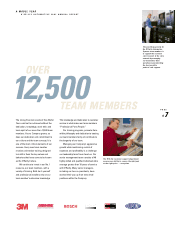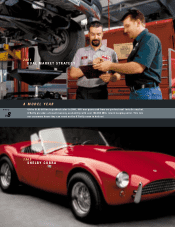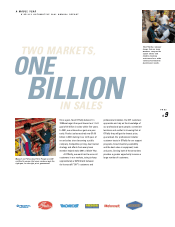O'Reilly Auto Parts 2001 Annual Report Download - page 19
Download and view the complete annual report
Please find page 19 of the 2001 O'Reilly Auto Parts annual report below. You can navigate through the pages in the report by either clicking on the pages listed below, or by using the keyword search tool below to find specific information within the annual report.
Page 17
Other expense, net, increased by $3.0 million from $3.9 million in
1999 to $6.9 million in 2000. The increase was primarily due to interest
expense on increased borrowings under our credit facility.
Provision for income taxes increased from $27.4 million in 1999
(37.5% effective tax rate) to $31.5 million in 2000 (37.8% effective tax
rate). The increase in the dollar amount was primarily due to the
increase of income before income taxes. The nominal increase in the
effective tax rate was primarily due to changes in the apportionment
of sales between states with differing tax rates.
Principally as a result of the foregoing, net income in 2000 was
$51.7 million (or 5.8% of product sales), an increase of $6.1 million
(or 13.3%) from net income in 1999 of $45.6 million (or 6.1% of
product sales).
LIQUIDITY AND CAPITAL RESOURCES
Net cash provided by operating activities was $50.0 million in 2001,
$5.8 million in 2000 and $31.6 million in 1999. The increase in cash
provided by operating activities in 2001 compared to 2000 is largely
the result of smaller increases in inventory, increased net income
and, to a lesser extent, increased accrued benefits and withholdings.
This increase in cash provided by operating activities in 2001
compared to 2000 was partially offset by the increase in amounts
receivable from vendors and a decrease in accounts payable and
other current liabilities. The decrease in cash provided by operating
activities in 2000 compared to 1999 is the result of an increase in
inventory and, to a lesser extent, increases in accounts receivable
and amounts receivable from vendors, partially offset by increases
in net income, accounts payable and accrued payroll.
Net cash used in investing activities was $77.8 million in 2001,
$40.5 million in 2000 and $79.7 million in 1999. The increase in cash
used in investing activities in 2001 was largely due to the purchase
of Mid-State as discussed in Note 2 of the consolidated financial
statements, and a significant reduction in the amount of proceeds
received from the sale of property and equipment. The decrease
in cash used in 2000 compared to 1999 was primarily due to
proceeds from the sale of 90 properties for $52.3 million in a
sale-leaseback transaction.
On December 15, 2000, we entered into a $50 million Synthetic
Operating Lease Facility (“the Facility”) with a group of financial
institutions. Under the Facility, the Lessor acquires land to be
developed for O’Reilly Auto Parts stores and funds our development
thereof as the Construction Agent and Guarantor. We subsequently
lease the property from the lessor for an initial term of five years and
have the option to request up to two additional successive renewal
periods of five years each from the lessor, although the lessor is
not obligated to grant us either renewal period. The Facility provides
for a residual value guarantee of approximately $36.6 million at
December 31, 2001, and purchase options on the properties. It also
contains a provision for an event of default whereby the Lessor,
among other things, may require us to purchase any or all of the
properties. We are utilizing the Facility to finance a portion of our
store growth. Funding under the Facility at December 31, 2001 and
2000, totaled $43.0 million and $1.0 million, respectively.
On December 29, 2000, we completed a sale-leaseback transaction.
Under the terms of the transaction, we sold 90 properties, including
land, buildings and improvements, for $52.3 million. The lease, which
is being accounted for as an operating lease, provides for an initial
lease term of 21 years and may be extended for one ten-year period
and two additional successive periods of five years each. The resulting
gain of $4.5 million has been deferred and is being amortized over the
initial lease term. Net rent expense during the initial lease term is
approximately $5.5 million annually and is included in the table of
future minimum annual rental commitments under noncancelable
operating leases. Proceeds from the transaction were used to reduce
outstanding borrowings under our revolving credit facility.
In August 2001, the Company completed a sale-leaseback with
O’Reilly-Wooten 2000 LLC (an entity owned by certain shareholders
of the Company). The transaction closed on September 1, 2001,
with a purchase price of approximately $5.6 million for nine O’Reilly
Auto Parts stores and did not result in a material gain or loss. The
lease, which has been accounted for as an operating lease, calls
for an initial term of 15 years with three five-year renewal options.
Capital expenditures were $68.5 million in 2001, $82.0 million in
2000 and $86.0 million in 1999. These expenditures were primarily
























